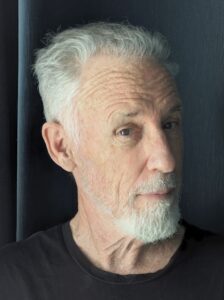About the website

This website is a collection of ideas, writings, and images that have resonated with me over time, exploring themes of culture, identity, the past and the present, alongside my more recent interests in the world of art.
Common Bones is inspired by Igami Bonkotsu (1875-1933), a master woodblock carver who played an early role in training Western woodblock artists. The characters for Bonkotsu (凡骨) literally read “common bones” and translates to “ordinary person”. His real name was Igami Junzo. Mine is Michael Harrington.
The website began with a singular focus: the life and work of Paul Jacoulet (1896–1960), a French woodblock artist who spent his entire life in Japan. Immersed in the culture from childhood, Jacoulet became a noted artist in what is arguably the most iconic of Japanese art forms. A flamboyant character, he was innovative in both technique and subject matter, making his prints instantly recognizable and highly collectible today. His life and art sit at an intriguing intersection of culture, identity, and artistic expression.
In addition to Jacoulet, the website includes a collection of photos, writing and artifacts from things I have done, places I have been and people that I have known. Things that have grabbed hold of me and stayed. But it is more than just a scrapbook. Rather, what inspires the collection is the poet W.C. Williams’ dictum: “No ideas but in things.”, that we need to attend to the here and now to really understand the abstractions that shape our lives. It is a call to look before you think. It is the objects, places, and actions we experience that give meaning – profound and mundane – to our lives.
A thread that runs through the content is the interplay of culture and identity. This comes from my long engagement with Japan and years of working in cross-cultural academic settings. The people I’ve had the privilege to know—colleagues, students, acquaintances, and friends—come from different countries, social groups, languages, and belief systems. In these spaces, culture and personal identity don’t just coexist; they converge, and sometimes collide.
The material is organised in two parts, the Jacoulet Archives and a section called Ideas and Things. There are also blogs related to both parts. Please join the mailing list if you want to receive updates. Comments or questions here.
The Jacoulet Archives
Paul Jacoulet (1896–1960) was a French woodblock artist who spent most of his life in Japan. Though often grouped with the shin-hanga movement, his work followed its own trajectory — technically masterful, visually arresting, and deeply personal. His subjects ranged from islanders in Micronesia to Chinese aristocrats and Japanese fishmongers, rendered with sensitivity, theatricality, and a flair for the unexpected.
There is no definitive biography of Jacoulet. The written record is limited, and some of what does exist is contradictory, embellished, or simply inaccurate. Jacoulet himself contributed to this ambiguity — a charismatic figure who at time shaped his own legend in interviews and public appearances, especially in Western press accounts of the time.
The Jacoulet Archives aims to gather what is known about his life and art. His story defies easy categories: he was a gay man in mid-century Japan, an expatriate navigating multiple cultural identities, a renowned butterfly collector, a classically trained musician, and the adoptive father of a Korean girl — the daughter of one of his long-time assistants. This project treats these threads — gender, aesthetics, identity, reinvention — as part of the richly layered tapestry in which that work was made, and through which we might better understand it today.
The Jacoulet Project brings together source material on Jacoulet’s life in English, Japanese and French. It is very much a work-in-progress. If you have something to contribute or feedback on what you see, I would love to hear from you. You can contact me below.
Ideas and Things
This is a collection of photos, writing and artifacts from things I have done, places I have been and people that I have known. It is divided into four sections.
- Living things, with sections on the four-footed, the winged, flora and scenes
- Objects, with subsections on things big and little, natural and mechanical
- Places, with subsections on Japan, Indonesia, Vietnam, Timor Leste and Oman,
- TekTeck FunRun Club, and a section devoted to the running club I joined when I was in Tokyo in the early 1980’s and to which I am still an active member – though we don’t do too much running these days.
The title is a play on W.C. Williams’ dictum: “No ideas but in things.” Pay attention to the material here and the immediate now. It’s the only show in town and it is yours and yours alone.
Fair use/fair dealing statement
This website contains copyrighted material, the use of which has not always been specifically authorized by the copyright owner. I am making such material available in an effort to advance understanding of how culture, identity and art intersect in exceptional individuals past and present. I believe this constitutes a fair use of copyrighted material as provided for in the United States, or fair dealing as provided for in Australia and other jurisdictions. I also recognise that copyright rules can vary across jurisdictions.
The material on this site is distributed without profit for research, educational, and informational purposes. If you wish to use copyrighted material from this site for purposes that go beyond fair use or fair dealing, you must obtain permission from the copyright owner. For more information on copyright exceptions, please refer to the relevant copyright laws in your jurisdiction.
Specifically, I believe my use of copyrighted material falls under the following purposes:
- Research or study
- Criticism or review
- Teaching or classroom use
If you are the copyright owner of any material used here and have any concerns, please contact me at contact@commonbones.org.
2. The nature of the copyrighted work.
3. The amount and substantiality of the portion used.